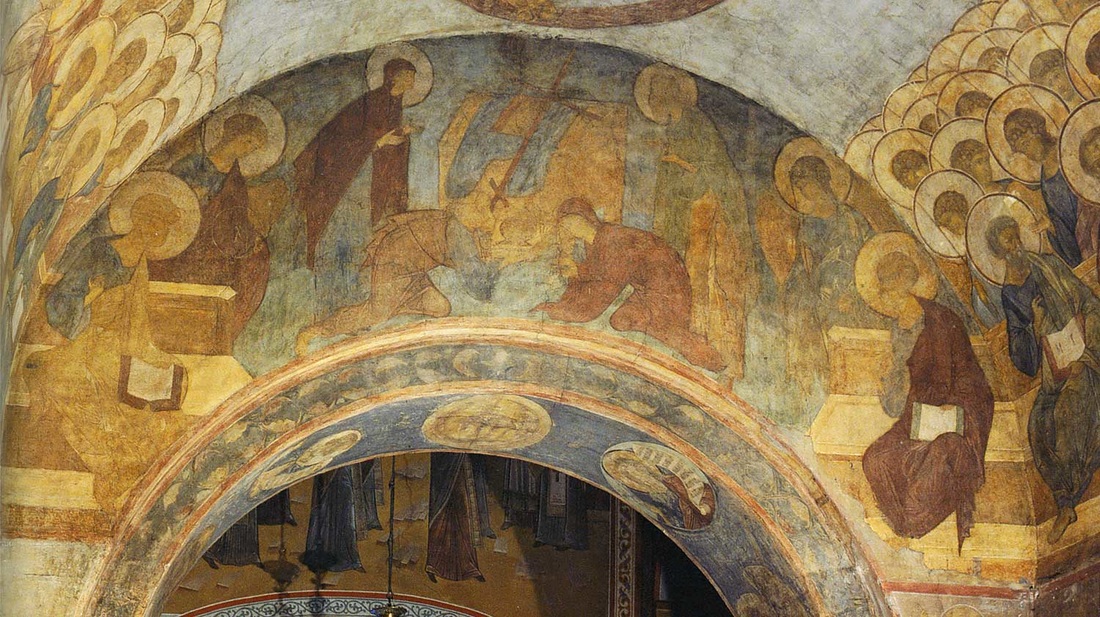Andrei Rublev (1966) by Andrei Tarkovsky
What is the relationship between an artist, the society and the period he lives and works in? In search for an answer a renowned film director Andrei Tarkvosky creates Andrei Rublev (1966), turning to the medieval Russian history and finding artistic and historical parallels with his life in the Soviet Russia. The movie is currently screening at British Film Institute at Southbank as a part of Mirroring Tarkovsky: The Russian Master and His Director Disciples season.
The film is set in the early 15th century Russia and consists of eight parts, each is focusing on a certain moment in the life of Andrei Rublev (ca. 1360s-1430), a monk icon painter. It also talks about his relationships with other monks, monastery workers and local authorities. The Soviet censorship banned the screenings of the movie in the country, deciding that it was a negative commentary on the current political situation in the Soviet Union. As a result, the movie reached the Russian audience only in 1988, after Tarkovsky’s death and the year of Rublev’s canonisation. Andrei Rublev is considered not only to be the greatest medieval Russian painter of Orthodox icons and frescoes, also the first known Russian artist. There is still not much know about his life and only few works have been attributed to him. He was a monk in the Trinity-St. Sergius Monastery close to Moscow, and a devout follower of St. Sergius. Taking a vow of silence, Andrei poured his passions into his paintings. As well as icons, Rublev executed a large number of fresco paintings, and worked on several illuminated manuscripts. A pupil of Theophanes the Greek (c.1340-1410), a Greek-born painter working in Russia, Rublev assisted him with the decoration of the Cathedral of the Annunciation in Moscow and in the Cathedral of the Dormition at Vladimir. Some may say that Tarkovsky turned his attention to Rublev’s story as a response to the cult of Rublev in 1960-70, but there are greater reasons of the director’s interest in this almost mythical figure. If one would like to describe the idea behind the movie in one phrase, ‘passions for Andrei’ might be the best one. Passions for Andrei was the original title of the script Tarkovsky started working with and it remained the main idea behind the work. The movie shows not only passions and struggles of an artist in a medieval state, but the worries of the whole nation during this period, trying to conquer the Mongol invasion. Tarkovsky once said, “Art exists to help us deal with the world’s imperfections.” The director, working in the Soviet Union and experiencing the censorship, believed that one of the most efficient ways to overcome the struggles of the time is to create. It is complicated to talk about Rublev due to the lack of factual information, and Tarkovsky uses his life more as a metaphor of the role of an artist in the society throughout centuries, his mission to create artworks, which will ease lives of people, who share the epoch with him. From this point of view, art could be compared with religion, serving similar goals, and that is yet another reason why Rublev is a perfect symbol. He is a monk, an icon painter and a faithful believer. Faith as art, soothes people, giving them hope and strength. Rublev lives and creates in one of the darkest and most desperate times in Russian history – the Mongol invasion, where people see only war, destructions, betrayal and death. Looking at the artist’s life against this hopeless background, Tarkovsky manages to highlight the artist’s role as a somewhat saviour for the nation, helping them to find hope and light through his works, fusing art and faith in his serene frescoes and icons. Rublev’s painting combines two important features: a sense of asceticism, and the harmony of Byzantine mannerism. And the figures in his paintings are invariably peaceful and calm. Perhaps for these reasons, his art came to be recognized as the epitome of religious orthodoxy and iconography. All these ideas are wonderfully welded together in the end of the film in one of the most vivid director’s devices. Shooting the entire movie in black and white, Tarkovsky dazzles the audience with close-ups of Rublev works, revealed here for the first time during the movie in all their brilliance and colour. After more than two hours of sombre and bleak imagery, the viewers are amazed by the beauty of the frescoes. The art, born from the endeavours and aspirations of the artist, is presented to the audience in its grandness, rising over the everyday as the man on the balloon in the beginning of the movie. This universal quality of artist and his work makes the historical period irrelevant, turning it into a simple background for the story. Andrei Rublev is considered the first Tarkovsky’s masterpiece; the work, where his signature director’s language manifested itself fully for the first time. This movie is not only about the artist, but even more so about the man, living in one of the most grim historical periods, believing in the salvation and the triumph of art despite the political and social situation.

The Last Judgement by Andrei Rublev, 1408 / Assumption Cathedral, Vladimir, Russia